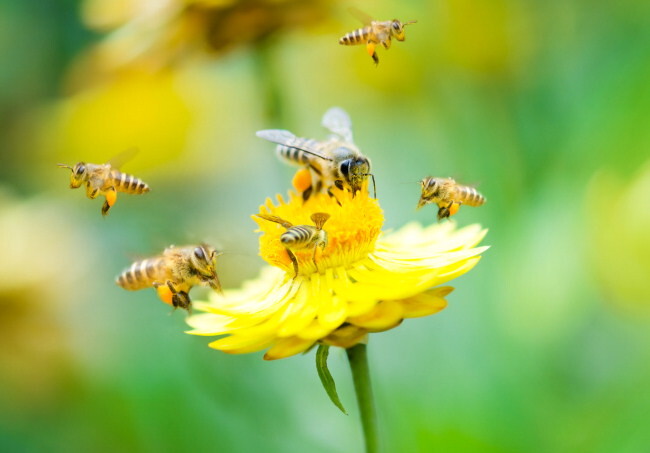
Bees are vanishing at a pace that demands attention. In a recent nationwide survey, US beekeepers reported losing 62 per cent of their managed honeybee colonies from June 2024 to February 2025 – the highest loss recorded in a single winter.
The losses represent more than an ecological crisis; they are a warning. The future of our food system and the delicate balance of nature itself are at stake.
Scientists agree that many factors are harming bees: changing climate, pests, diseases and pesticides – and the interplay of all these. The picture is complex, but the evidence points to one factor that stands out as both a key contributor and a controllable risk: neonicotinoids (neonics), the world’s most widely used insecticides.
In 2006, beekeepers in the United States began reporting persistent hive losses, a phenomenon that came to be known as colony collapse disorder (CCD). Many suspected neonics, a relatively new class of insecticides. The beekeepers observed links between CCD and the proximity of their hives to fields treated with neonics, and they noted that problems often emerged months after initial exposure – suggesting that contaminated pollen and nectar were weakening colonies over time.
Introduced in the early 1990s, neonics were originally marketed as a safer alternative to older insecticides. The chemicals are neurotoxic; they work by targeting the nervous systems of insects. They are also systemic, meaning they infuse plants – from stems and leaves, to pollen and nectar.
By the mid-2000s, neonic use had surged in the United States, largely due to seed coatings that promised to protect plants before farmers could even spray. Today, neonic-treated seeds are ubiquitous in the United States, coating nearly all conventional corn seeds and many soybean, wheat, canola, and cotton seeds.
Hundreds of scientific studies now support what beekeepers suspected: Low, field-realistic doses of neonics have persistent and sub-lethal effects on bees. These studies provide strong evidence that neonics weaken bees in multiple ways – disrupting their ability to navigate and forage, damaging memory and reproduction and suppressing immune function, making bees more susceptible to other stressors such as diseases and parasites.
Based on the strength of this evidence, some governments are taking action. In 2013, citing a “confirmed risk” to bees, the pollen and nectar banned the outdoor use of three bee-toxic neonics on crops attractive to bees.
In 2019, Quebec imposed strict limits on neonic-coated seeds that sharply reduced their use. Evidence from both regions suggests that the restrictions have not led to significant crop yield losses.
Yet in the United States, where bee losses hit record highs last winter, neonics remain widely used. Why?
Decades of corporate influence and regulatory weakness have stalled US action on neonics. Major pesticide producers and their trade groups spend at least $16 million a year lobbying Congress and regulatory agencies, according to OpenSecrets.org, a nonpartisan non-profit that tracks money in US politics (and the figure may be far higher when accounting for additional industry participants and indirect lobbying efforts such as funding studies or front groups to influence policymakers). Industry personnel frequently move into government roles, and vice versa, reinforcing industry sway.
Regulators often depend on industry-funded research – despite substantial evidence showing that such studies are more likely to support corporate interests.
At US Right to Know, we uncovered documents showing how companies like Bayer try to influence scientific discourse on bees. In one case, Bayer pushed researchers to remove photos implicating a defective neonic-coated seed in bee deaths; in another, a university contract gave Bayer control over study design and publication.
Our research has also tracked how pesticide companies spend tens of millions of dollars a year on public relations campaigns and front groups that downplay pesticide risks. This influence extends into academic institutions, scientific conferences, and professional organizations.
One key industry narrative is to blame bee declines on the varroa mite, a parasitic arachnid that feeds on the blood of honeybees. But when United Kingdom-based researcher James Cresswell raised doubts about the mite hypothesis in a Syngenta-funded study, the company pressured him to revise his findings, according to the New York Times.
“Syngenta has clearly got an agenda,” Cresswell told the Times, and elaborated via email that their agenda was “It’s the varroa, stupid.”
Bayer also leaned heavily on the mite narrative. Bayer’s “Bee Care” centre in Germany featured a prominent sculpture of a varroa mite, while its $2.4 million North American Bee Care Centre – launched in 2014 to positive media coverage – framed the bee crisis as a biological threat, not a chemical one. Internal documents reported on by journalist Rebecca Raney suggest the real aim of the Bee Care programme: Bayer staff celebrated it as a successful crisis public relations strategy, according to emails. The company quietly shut down the North American Bee Care Centre in 2019.
To be clear: Varroa mites do threaten bees. But research shows that neonics weaken bee immune systems, making colonies more vulnerable to mites and disease – placing pesticides at the root of a problem they are often blamed for merely compounding.
Meanwhile, independent studies, including from Cornell University, question the economic necessity of neonics, showing little benefit to corn and soy farmers.
Corporate sponsorship perks at the Entomological Society of America conference included a “pet a puppy event,” a mini golf exhibit with branded golf balls, promotional emails to members and ads in a scientific journal.
Pesticide companies influence the discourse on bees in many ways. At the world’s largest entomology conference, for example, Raney’s research found that pesticide companies paid nearly $1 million in sponsorship fees over a seven-year period. During that same period, discussion of neonics at the conference waned. (The most recent conference has since paused this trend.)
Even the honey industry played a part in deflecting blame from neonics. When US honey tested positive for neonics and glyphosate – an herbicide linked to cancer and other health harms – the National Honey Board hired the PR firm Porter Novelli to manage public perception. Porter Novelli was also working for Bayer at that time to promote neonics and oppose legislation aimed at protecting pollinators. The firm also partnered with the pesticide-funded group Growing Matters to generate and amplify studies framing neonics as an economic necessity for farmers.
Flawed regulatory standards in the United States play a key role in the continued widespread use of neonics. Under the Federal Insecticide, Fungicide and Rodenticide Act (FIFRA), the United States operates under a reactive regulatory model that requires proof of harm before restrictions can be imposed. The burden lies on scientists and regulators – not on industry – to demonstrate that a product poses unacceptable risks.
By contrast, the European Union (EU) follows a precautionary approach: If credible evidence suggests a significant risk to health or the environment, action can be taken before full scientific certainty is reached. This difference in regulatory philosophy has profound implications for pollinator protection and pesticide approval.
Current US pesticide risk assessment protocols fail to adequately capture the complexity of real-world exposures. Regulators primarily rely on laboratory studies of short-term, single-chemical exposures, often conducted or funded by industry. These studies typically ignore how pesticides accumulate in the environment, interact with each other, and combine with other stressors – such as climate change, disease, and habitat loss – that bees face in the field.
In the United States, pesticide regulation often privileges a control-oriented approach to laboratory and field studies that measure isolated factors and look for lethal effects. Regulators often give lesser attention to complexity-oriented approaches that consider low-level exposures or sub-lethal effects over time, or interactions with other pesticides or pathogens. This narrow evidence base tends to underestimate risks.
Yet when beekeepers and independent scientists present field data showing widespread bee declines and pesticide impacts, regulators frequently dismiss it as “too variable” or “inconclusive.” In effect, the uncertainties of field conditions become a justification to delay action, while the controlled simplicity of lab studies – many produced by industry – serves to legitimise continued use. This dynamic, where only certain types of evidence are considered valid, helps sustain what sociologist Jennie Durant calls an “ignorance loop”: a cycle in which scientific uncertainty is reinforced and reproduced.
Scholars Sainath Suryanarayanan (who consults with US Right to Know) and Daniel Kleinman describe this process as “manufactured ignorance” – not a lack of data, but a system that actively filters out inconvenient knowledge
- A Tell Media report / Adapted from US Right to Know







